You'll need different temperatures for rendering various animal fats effectively. Start beef fat at 250°F to 275°F, pork fat at 225°F to 250°F, and duck or chicken fat at a gentler 190°F to 220°F. For high-quality suet rendering, begin at 130°F to 140°F. Always use a kitchen thermometer to monitor temperature and prevent burning. Understanding these specific heat ranges will transform your fat rendering results and reveal endless culinary possibilities.
The Science Behind Fat Rendering Temperatures
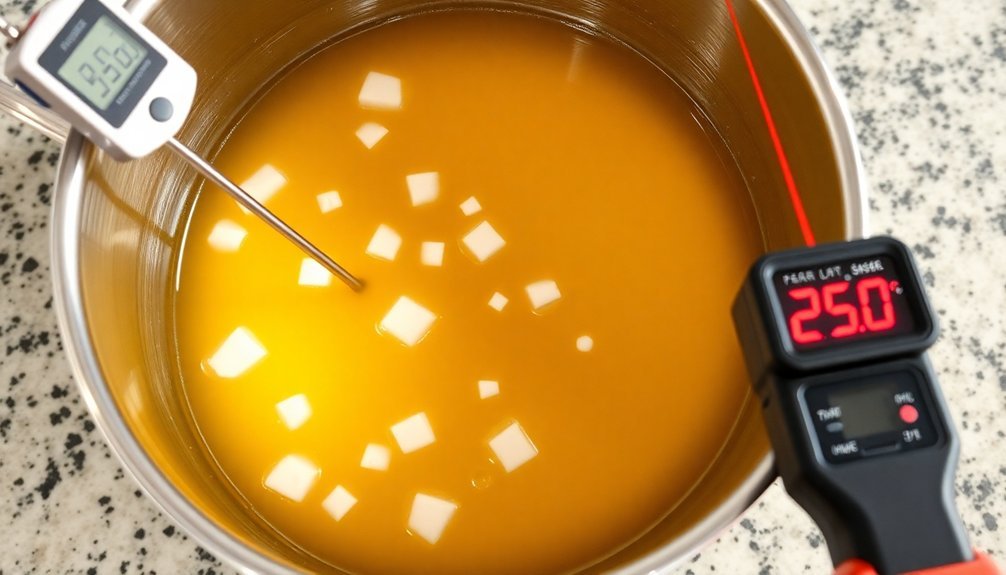
While rendering animal fats might seem straightforward, understanding the science behind temperature control makes all the difference in producing high-quality results.
Fat rendering begins at relatively low temperatures, between 130°F and 140°F, when the fat starts melting away from connective tissues.
For ideal results, you'll want to maintain medium low heat between 250°F and 275°F. This temperature range guarantees even melting without burning while allowing the Maillard reaction to develop complex flavor profiles in your rendered fat.
It's vital to keep consistent heat throughout the process, as temperature fluctuations can lead to uneven rendering or burnt flavors. Using a kitchen thermometer isn't just helpful—it's necessary for monitoring the exact temperature and achieving the perfect render every time.
Essential Equipment for Temperature Control
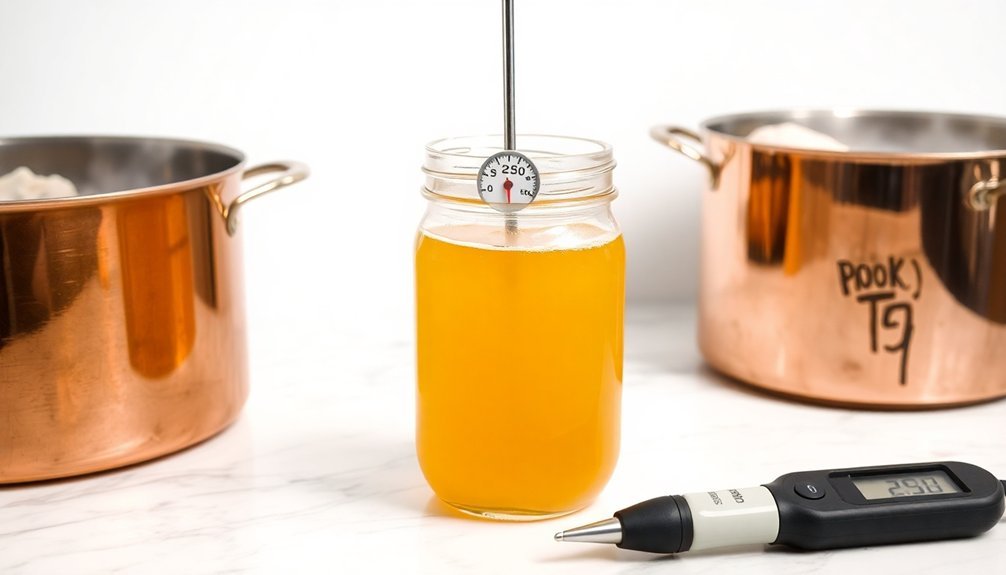
Having the right tools makes all the difference in maintaining proper temperatures during fat rendering. You'll need a kitchen thermometer to monitor the essential temperature range of 250-275°F while your fat melts. A deep saucepan guarantees even heat distribution for consistent temperature control throughout the rendering process.
| Equipment | Purpose | Impact |
|---|---|---|
| Kitchen Thermometer | Temperature Monitoring | Prevents Overheating |
| Deep Saucepan | Even Heat Distribution | Controls Melting Rate |
| Sharp Knife | Cutting 1.5" Chunks | Guarantees Even Rendering |
| Fine-Mesh Sieve | Removing Impurities | Improves Clarity |
| Storage Container | Proper Storage | Maintains Quality |
Cut your fat into uniform chunks before starting. As you render, use your thermometer frequently and strain the finished product through a sieve to remove impurities. This attention to equipment and process will appreciably enhance your cooking performance with the rendered fat.
Optimal Heat Ranges for Different Animal Fats
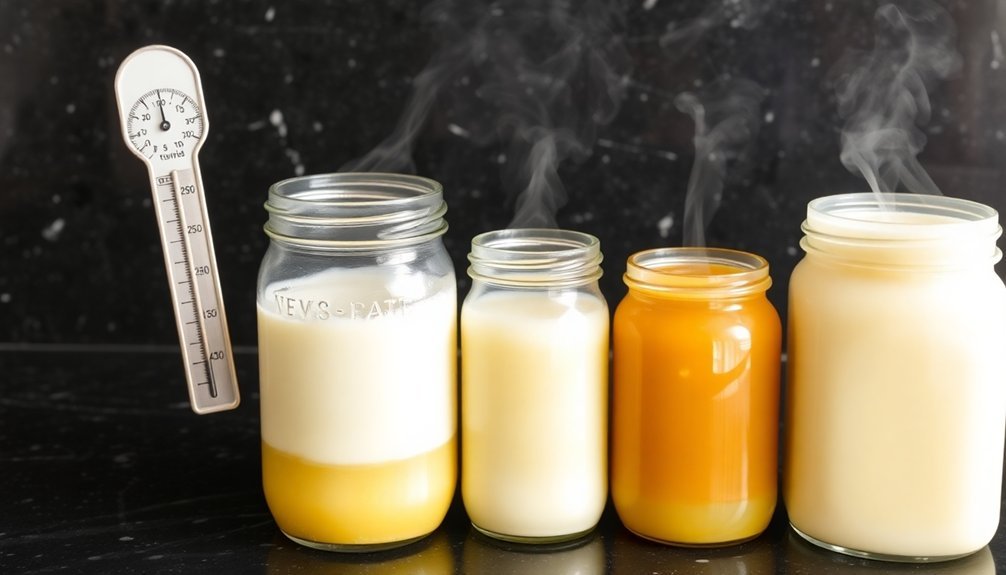
Each type of animal fat requires its own specific temperature range for ideal rendering.
You'll find that proper temperature control is vital for achieving the perfect smooth texture and maximizing flavor extraction in rendered fat.
- Beef fat needs the highest heat at 250-275°F for best rendering temperature, guaranteeing even melting without burning.
- Pork fat renders best between 225-250°F, creating a cooking method that yields pure, clean lard.
- Duck fat requires gentler treatment at 190-210°F to preserve its delicate flavor profile.
- Chicken fat (schmaltz) renders beautifully at 200-220°F for maximum flavor extraction.
When rendering suet into tallow, you'll want to maintain the lowest temperature range of 130-140°F.
This slow cooking method guarantees you're getting the highest quality rendered fat while preserving its essential properties.
Monitoring and Adjusting Heat During Rendering
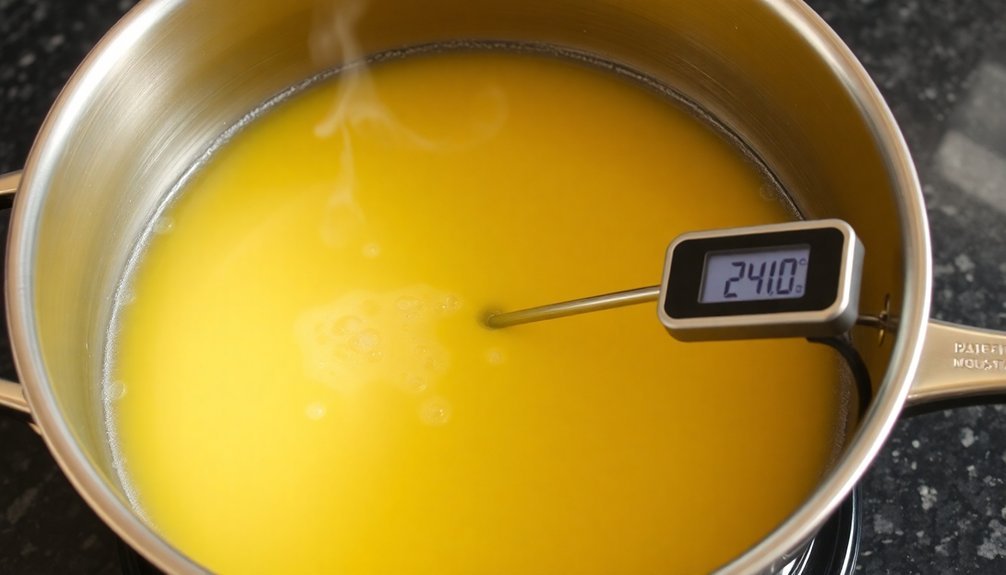
Now that you understand the ideal temperature ranges, successful fat rendering depends on careful heat monitoring throughout the process.
Using a kitchen thermometer, you'll want to maintain temperatures between 250°F and 275°F (121-135°C) to achieve even melting without burning.
Keep a close eye on your thermometer readings and adjust your heat accordingly. If you notice the fat starting to smoke or bubble aggressively, quickly reduce the temperature.
When rendering suet, start with lower heat and gradually increase it for best results.
Don't forget to stir the fat occasionally during the process – this helps maintain consistent temperatures and guarantees thorough melting.
Your careful monitoring will prevent burnt flavors and guarantee a high-quality rendered fat that's perfect for cooking.
Storage Requirements After Temperature Treatment
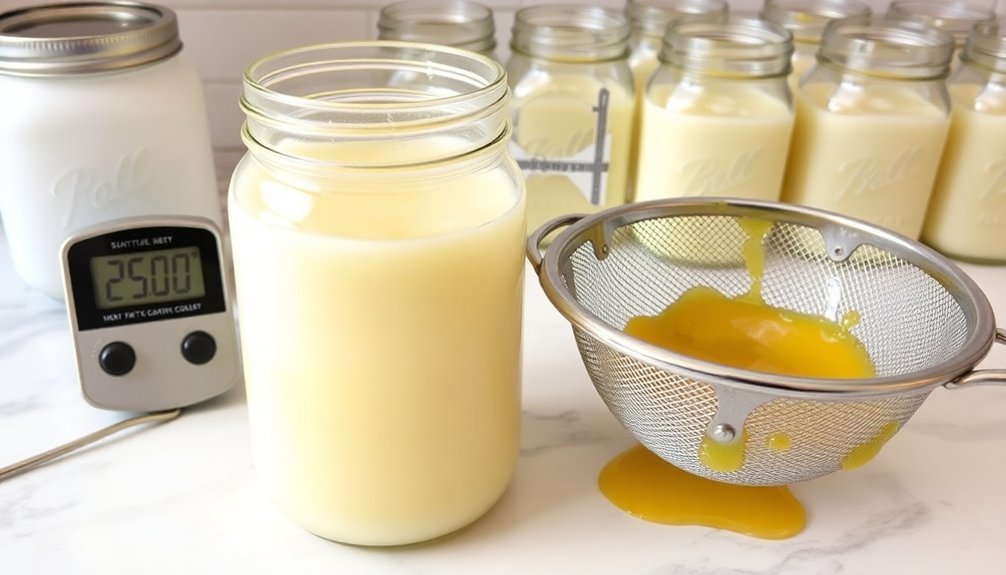
Once your rendered animal fats have cooled completely, proper storage becomes critical for maintaining their quality and extending shelf life.
After temperature treatment, let your fats cool uncovered until they solidify to prevent moisture-induced spoilage.
For best storage after rendering, you'll need to follow these key steps:
- Transfer cooled fats to airtight containers, ensuring no moisture is present.
- Store in the refrigerator for 1-2 months of freshness.
- Use freezer-safe containers for long-term storage up to one year.
- Keep containers in dark, cool locations to prevent rancidity.
Always inspect your stored fats for black mold or unusual odors before use.
Frequently Asked Questions
At What Temperature Does Animal Fat Render?
Animal fats start rendering at 130-140°F, but you'll want to maintain temperatures between 250-275°F for ideal results. Don't exceed this range, or you'll risk burning the fat and creating off-flavors.
How Long to Render Tallow at 225?
You'll need 4-6 hours to render tallow at 225°F. Keep an eye on the process and maintain steady heat. For best results, cut your fat into 1.5-inch chunks before you begin rendering.
What Is the Best Temperature to Render Lard?
You'll get the best results rendering lard between 250°F and 275°F. Keep a close eye on your thermometer, as this range guarantees proper melting without burning while preserving the lard's quality and flavor.
What Temp Does Animal Fat Burn?
You'll notice animal fats start to burn around 350°F (177°C). If you're cooking with lard or tallow, don't exceed their smoke points of 370-400°F, or you'll risk creating harmful compounds and off-flavors.
In Summary
Successful fat rendering depends on maintaining proper temperatures throughout the process. You'll get the best results by keeping your temperatures between 225-250°F for most animal fats, though you'll need to adjust based on the specific fat you're working with. Remember to monitor closely using a reliable thermometer, and don't exceed 375°F to avoid burning. Store your rendered fats in airtight containers once they've cooled completely.
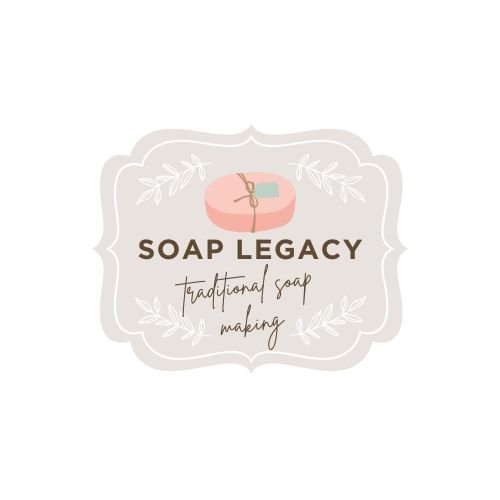

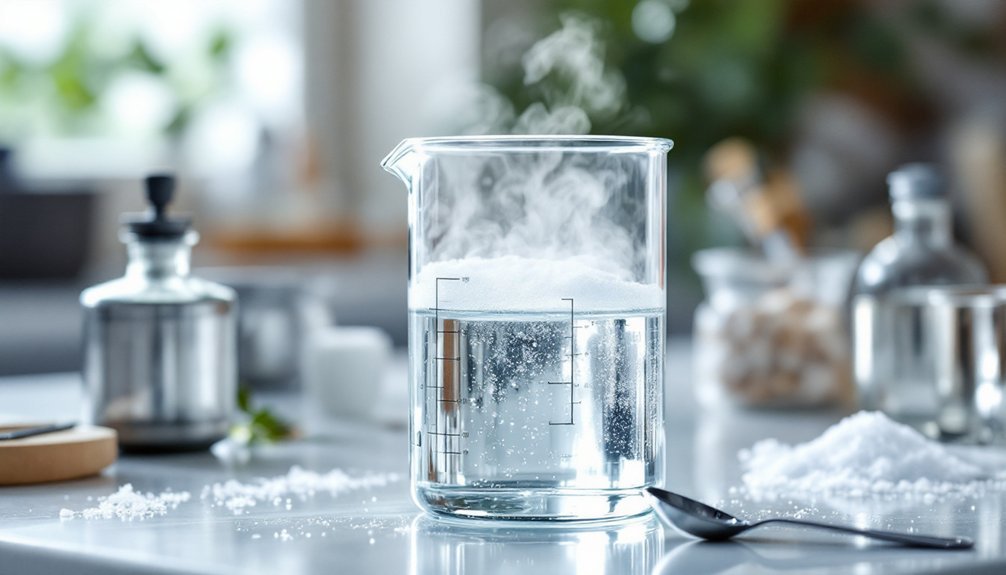
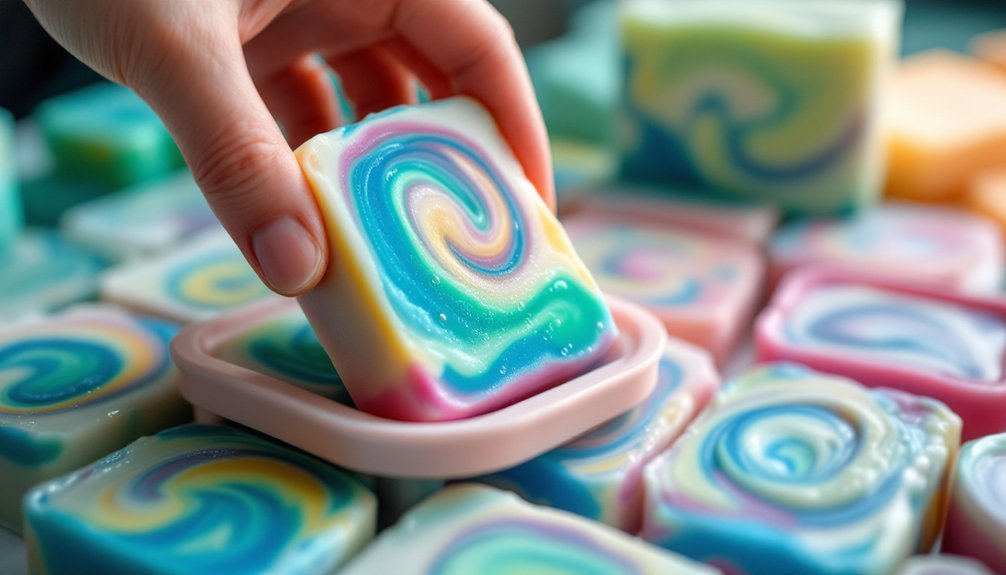
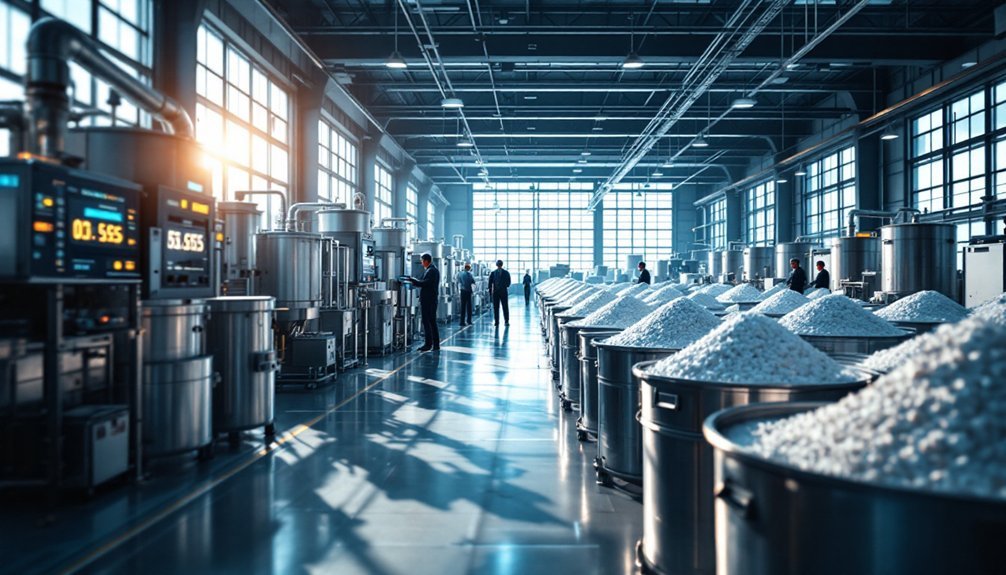
Leave a Reply